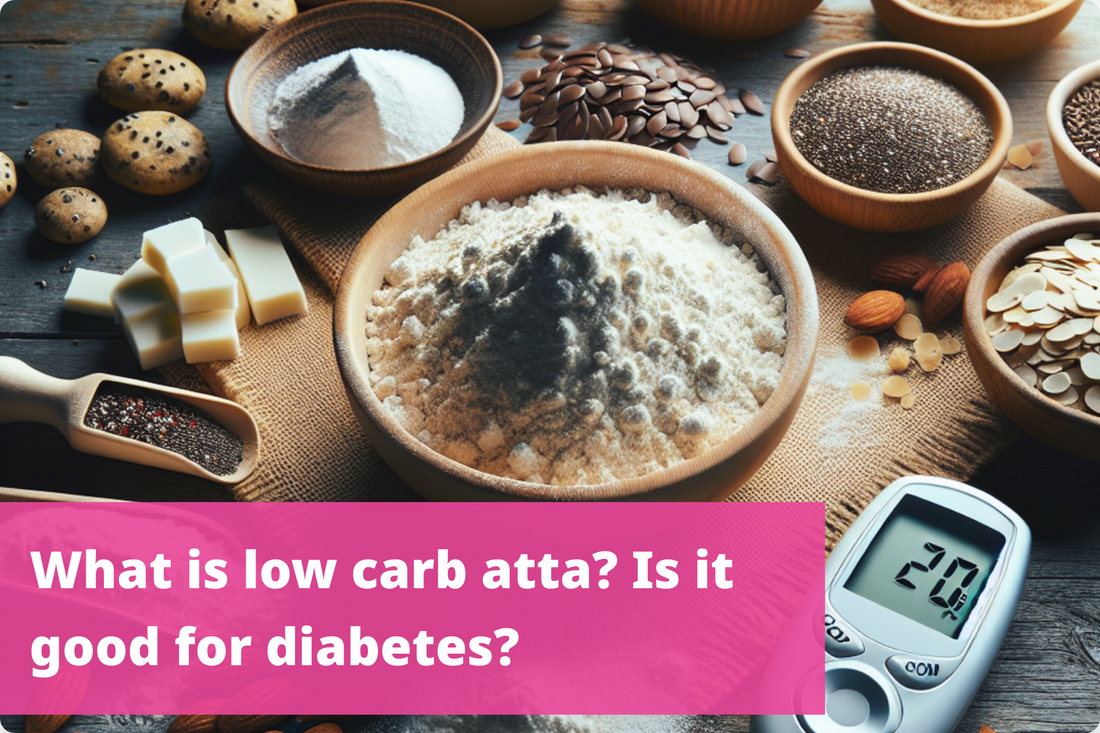In recent times, the spotlight has shifted to a culinary ingredient that's creating waves in health-conscious circles—low carb atta. Particularly gaining popularity in India, this special flour has piqued the interest of many, especially those grappling with diabetes. But what exactly is low carb atta?
Essentially, low carb atta is a flour variant crafted with a deliberate reduction in carbohydrates compared to traditional atta. It's an essential for those keen on managing their carbohydrate intake, a crucial aspect for individuals with diabetes.
Now, let's look into the why. Diabetes, as we all know, demands meticulous attention to what we consume. Low carb atta emerges as a potential game-changer for those looking to strike a balance between culinary delight and health consciousness. It's not just a dietary trend; it's a practical approach to making our everyday meals diabetes-friendly.
As we embark on this journey of understanding low carb atta, we'll unravel its composition, explore its impact on blood sugar levels, and even take a peek into its seamless integration into our beloved Indian cuisine. So, buckle up for a culinary adventure that not only caters to your taste buds but also aligns with your health goals.
Understanding Low Carb Atta
Low carb atta, also known as low carb flour or flour with reduced carbohydrate content, is specifically designed to have fewer carbohydrates compared to traditional flours like whole wheat or all-purpose flour. Here are the key points that explain low carb atta:
Reduced Carbohydrate Content: Low carb atta is formulated to contain fewer carbohydrates per serving compared to regular flours. It typically achieves this by using a combination of ingredients that are lower in starch and sugars.
Higher Protein Content: To compensate for the reduction in carbohydrates, low carb atta often contains a higher proportion of protein. Protein helps in maintaining muscle mass, supports satiety, and can aid in managing blood sugar levels.
Lower Glycemic Index: Low carb atta tends to have a lower glycemic index (GI) compared to traditional flours. Foods with a lower GI release glucose more slowly into the bloodstream, helping to avoid spikes in blood sugar levels.
Rich in Fiber: Some varieties of low carb atta may also be enriched with dietary fiber. Fiber aids in digestion, promotes a feeling of fullness, and helps regulate blood sugar levels.
Suitable for Diabetes Management: Due to its lower carbohydrate content and lower GI, low carb atta is considered suitable for individuals managing diabetes. It can help in maintaining more stable blood sugar levels compared to higher-carb alternatives.
Impact on Blood Sugar Levels
Numerous studies and expert opinions suggest that the controlled carbohydrate content in low carb atta can have a positive influence on blood sugar levels. By opting for this alternative, individuals with diabetes can potentially avoid the spikes and crashes associated with traditional high-carb flours.
The secret sauce here lies in the slower digestion and absorption rate of the carbohydrates present in low carb atta. This slow and steady release of glucose into the bloodstream helps in preventing sudden spikes, providing a more stable and manageable blood sugar profile.
It's not just about managing diabetes; it's about empowering individuals to take charge of their health through informed dietary choices. So, if you've been grappling with the constant ebb and flow of blood sugar levels, low carb atta might just be the ally you've been searching for. As we explore further, you'll discover how seamlessly this flour integrates into our traditional Indian recipes, making the journey towards a balanced and diabetes-friendly diet all the more flavorful.
Low Carb Atta Ingredients
Grain/Ingredient |
Characteristics |
Usage in Low Carb Atta |
|---|---|---|
Almond Flour |
High in protein, low in carbohydrates; gluten-free and rich in healthy fats. |
Used as a base in low carb baking and cooking. |
Coconut Flour |
High in fiber, moderate protein, low in carbohydrates; gluten-free and absorbs moisture well. |
Blended with other flours for baking. |
Soy Flour |
High in protein, moderate in carbohydrates; gluten-free and versatile in cooking. |
Used to increase protein content in low carb atta. |
Flaxseed Meal |
High in fiber, moderate protein, low in carbohydrates; adds texture and nutty flavor. |
Mixed with other flours for baking and cooking. |
Chia Seed Flour |
High in fiber, protein, and healthy fats; low in carbohydrates; gluten-free and thickening properties. |
Blended with other flours for baking. |
Psyllium Husk Powder |
Very high in fiber, low in carbohydrates; gluten-free and helps in binding. |
Used as a binding agent in low carb baking. |
Wheat Bran |
High in fiber, moderate protein, and carbohydrates; adds texture and nutrients. |
Mixed with other flours to reduce carb content. |
Health Benenfits of Low Carb Atta
1. Improved Blood Sugar Control: Low carb atta helps in stabilizing blood sugar levels due to its reduced carbohydrate content and lower glycemic index compared to traditional flours. This benefit is particularly important for individuals with diabetes or those aiming to manage insulin resistance.
Weight Management Support: By reducing carbohydrates and potentially increasing protein and fiber content, low carb atta can aid in weight management. Protein and fiber promote satiety, reducing overall calorie intake and supporting healthy weight loss or maintenance.
Reduced Risk of Insulin Resistance: Lower carbohydrate intake from low carb atta may help reduce the risk of developing insulin resistance, a precursor to type 2 diabetes. It supports better insulin sensitivity and metabolic health.
Heart Health Benefits: Low carb atta often contains higher amounts of heart-healthy fats, proteins, and fiber compared to refined flours. These nutrients can help lower cholesterol levels, reduce inflammation, and support cardiovascular health.
Digestive Health Support: High fiber content in some varieties of low carb atta supports digestive health by promoting regular bowel movements and maintaining gut health. Fiber also aids in preventing constipation and other digestive issues.
Nutrient Density: Depending on the ingredients used, low carb atta can be enriched with vitamins, minerals, and antioxidants, contributing to overall nutrient intake and health benefits.
Suitability for Gluten-Free Diets: Some variants of low carb atta, such as those made from almond flour or coconut flour, are naturally gluten-free. This makes them suitable for individuals with gluten intolerance or celiac disease, supporting digestive and immune health.
Low Carb Atta in Indian Cuisine
The acceptance of this flour variant in Indian households goes beyond just a health trend; it caters to our cultural preferences and dietary habits. Picture this: your favourite Indian dishes, now with a diabetes-friendly twist. Rotis, a quintessential part of our meals, can be crafted with low carb atta, offering a lighter and healthier alternative. The beauty lies in its adaptability – low carb atta doesn't just restrict itself to one type of dish; it effortlessly weaves into the diverse fabric of our culinary traditions.
The acceptance of low carb atta in Indian households isn't just about health-conscious choices; it's about preserving the essence of our culinary heritage. It accommodates the need for a diabetes-friendly diet without compromising on the flavours we hold dear. From fluffy naans to aromatic parathas, these dishes, when made with low carb atta, become not just a treat for the taste buds but also a mindful choice for those managing diabetes.
Low carb atta, more than a trend
As we finish our look into the world of low carb flour, let's summarise the main points that can affect your choices for a healthier, diabetes-friendly lifestyle.
Low carb atta isn't just a food trend; it's a practical solution for people managing diabetes. With less carbohydrates and often mixed with nutrient-rich alternatives, it's a good option for those aiming for a well-rounded diet without sacrificing flavour.
One crucial thing to think about is its effect on blood sugar levels. Studies and experts suggest that choosing low carb atta may have benefits, helping maintain more stable blood sugar levels. This controlled release of glucose into the bloodstream can be a helpful tool in managing diabetes.
As we embrace the use of low carb atta in our favourite Indian dishes, it's important to acknowledge its growing acceptance in households. This type of flour not only supports healthy choices but also respects our cultural preferences and eating habits. Whether it's rotis or naans, the versatility of low carb flour lets us enjoy our favourite foods with a health-conscious twist.
However, a word of caution: while low carb atta seems promising, it's important to remember that everyone's dietary needs are different. Recommendations and warnings should be tailored to each person, stressing the need to consult with healthcare professionals. They can offer personalised advice based on your specific health conditions and goals.
This Blog post is an initiative by DiabeSmart, to provide accurate and Nutritionist / Doctor approved information related to Diabetes. DiabeSmart is India's first Food brand designed specifically for Diabetics, that has been clinically tested on Diabetics and Pre-Diabetics to deliver 55% - 70% lower Sugar spikes. DiabeSmart is part of Lo! Foods - India's leading brand for Everyday Functional Health foods.















